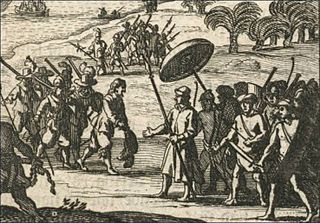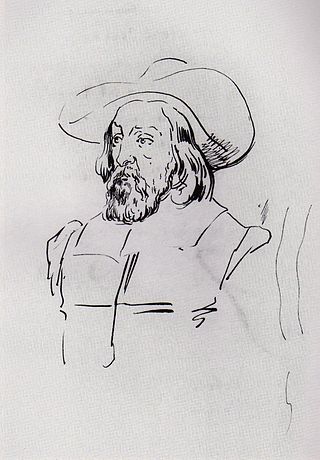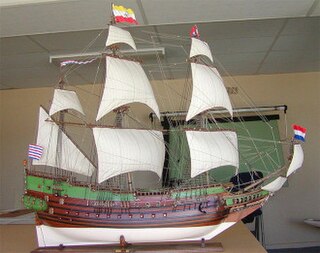
The Dutch West India Company was a Dutch chartered company that was founded in 1621 and went defunct in 1792. Among its founders were Reynier Pauw, Willem Usselincx (1567–1647), and Jessé de Forest (1576–1624). On 3 June 1621, it was granted a charter for a trade monopoly in the Dutch West Indies by the Republic of the Seven United Netherlands and given jurisdiction over Dutch participation in the Atlantic slave trade, Brazil, the Caribbean, and North America.

The United East India Company, commonly known as the Dutch East India Company, was a chartered trading company and one of the first joint-stock companies in the world. Established on 20 March 1602 by the States General of the Netherlands amalgamating existing companies, it was granted a 21-year monopoly to carry out trade activities in Asia. Shares in the company could be purchased by any citizen of the Dutch Republic and subsequently bought and sold in open-air secondary markets. The company possessed quasi-governmental powers, including the ability to wage war, imprison and execute convicts, negotiate treaties, strike its own coins, and establish colonies. Also, because it traded across multiple colonies and countries from both the East and the West, the VOC is sometimes considered to have been the world's first multinational corporation.
The following lists events that happened during the 1600s in South Africa.

Sebald or Sebald de Weert was a Flemish captain and vice-admiral of the Dutch East India Company. He is most widely remembered for accurately plotting the Falkland Islands in 1600.

Joris van Spilbergen was a Dutch naval officer.

Rijcklof Volckertsz. van Goens was the Governor of Zeylan and Governor-General of the Dutch East Indies. He was the Governor of Zeylan from 12 May 1660 to 1661, then in 1663 and finally from 19 November 1664 to 1675 during the Dutch period in Ceylon. He was also served as Council Member of India during 1679. Van Goens’ managed to monopolize the cinnamon trade, get hold of the Malabar pepper and drive away the Portuguese from Ceylon and the Coromandel Coast for the VOC.
Hendrik Godfried Duurkoop was a Dutch merchant-trader and VOC Opperhoofd in Japan. During his career with the Dutch East Indies Company, he worked on Dejima, a small artificial island in the harbor of Nagasaki, Japan.
Femme Simon Gaastra was a Dutch Professor of maritime history at the University of Leiden and a leading expert on the history of the Dutch East India Company.

The Compagnie van Verre was one of the forerunner companies that were later merged (united) into the Dutch East India Company.

The Brabant Company, also known as the New Company, was a precursor of the Dutch East India Company (VOC).

Pieter Anthoniszoon Overtwater, also known as Anthonisz. or over 't Water, was a merchant/trader and official of the Dutch East India Company.

Isaac Le Maire was a Dutch entrepreneur, investor, and a sizeable shareholder of the Dutch East India Company (VOC). He is best known for his constant strife with the VOC, which ultimately led to the discovery of Cape Horn.
Jacobus Ruurd "Jaap" Bruijn, was a Dutch maritime historian. He was professor of maritime history at the University of Leiden from 1979 until his retirement in 2003. During his 41-year teaching career as The Netherlands' only university professor of maritime history, he guided the doctoral theses of at least 49 graduate students.

The Dutch East India Company was a chartered company which issued a considerable series of coinage in bronze, silver and gold for its territories in the Far East between 1602 and 1799.

Gerrit Pieter Bicker (1554–1604) was a Dutch merchant, patrician, and one of the founders of the Compagnie van Verre and its successor the Dutch East India Company.
Balthazar de Moucheron (1552–1630) was a Dutch trader, ship owner, and one of the founders of the Dutch East India Company, but never participated as he went bankrupt in the same year. He is known for his early trading with India (Calcutta) and Indonesia, America, the west coast of Africa, the Baltic Sea, and the White Sea (Archangelsk).

A voorcompagnie (pre-company) is the name given to trading companies from the Republic of the Seven United Netherlands that traded in Asia between 1594 and 1602, before they merged to form the Dutch East India Company (VOC). The pre-companies were financed by merchants from the Northern Netherlands and rich immigrants from the Southern Netherlands. Because of the deadly competition, the government forced the smaller trading companies to unite and form the (United) East India Company. In its turn, it received the exclusive rights for the trade with Asia for the following 21 years.

The Veerse Compagnie was a pre-company from the Republic of the Seven United Netherlands that was founded by Balthazar de Moucheron, a ship owner from Antwerp in the Southern Netherlands. After the fall of Antwerp in 1585, he moved his business to Zeeland. The fleet of the Veerse Compagnie was made up of two ships; 'Leeuw' (Lion) and 'Leeuwin' (Lioness) and was headed by Cornelis Houtman. Its fleet left from Veere on 28 March 1598 and returned to the Republic of the Seven United Netherlands in 1600.

The Old Company was a pre-company of the Dutch Republic and originated from the Company of Verre and the New Company, from Amsterdam, in 1598. The directors were Dirck van Os, Jan Hermansz, Jan Janss Carel (Kaerel) and Geraerdt (Gerrit) Bicker. Directors with a smaller share of the investment were: Vincent van Bronckhorst, Symon Jansz Fortuyn, Geurt Dircxz, Cornelis van Campen, Jacob Thomasz Van den Dael, Elbert Simonsz Jonckheyn, Petrus Plancius, Syvert Sern, Jan Poppe, Geurt Dirckss and Pieter Hasselaer. The Old Company and the (New) Brabant Company would merge in 1601 and become the United Amsterdam Company.

The Oosterland was a large 17th-century East Indiaman of the Dutch East India Company. The VOC was established in 1602. The ship was wrecked along with another ship by the ship the Kallendijk on 24 May 1695. The shipwreck was discovered by amateur divers in 1988 on the South African coast a few hundred metres from the entrance to Milnerton Lagoon at the mouth of the Salt River. Excavation of the wreck started in the early 1990s in combination with the University of Cape Town and was led by Bruno Werz.













